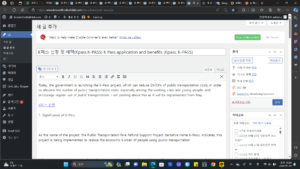Today, the government is launching the K-Pass project, which can reduce 20-53% of public transportation costs, in order to alleviate the burden of public transportation costs, especially among the working class and young people, and encourage regular use of public transportation. I am posting about this as it will be implemented from May.K패스 신청
1. Significance of K-Pass

As the name of the project, the Public Transportation Fare Refund Support Project (tentative name K-Pass), indicates, this project is being implemented to reduce the economic burden of people using public transportation.
K-Pass overcomes the shortcomings of an economical transportation card that refunds a certain percentage of the amount used (20% for general people, 30% for young people, 53% for low-income people) if you regularly use public transportation such as city buses or subways more than 15 times a month. This supplemented transportation card is scheduled to be implemented from May 2024.
For example, if you spend an average of 100,000 won on public transportation every month, using the K-Pass can save 20,000 won for the general public, 30,000 won for young people, and 53,000 won for low-income people.
The economical transportation card currently in effect had the inconvenience of recording departure and arrival each time and providing mileage based on the distance traveled. However, the K-Pass has the convenience of not having to “record the distance traveled” since it is refunded based on the amount spent.
2. K-Pass Target (Business Method)
K-Pass is supported for public transportation in most areas of the country, including city buses, metropolitan buses, subways, private railways (Shinbundang Line), and metropolitan area rapid transit (GTX)-A. It is planned to expand to 189 local governments by May 2024, when the project begins, and K-Pass will be implemented in almost all local governments except for some areas with a population of less than 100,000, so it is expected to become Korea’s representative public transportation support project. It is expected.
*(Currently 176) All major local governments including Seoul, Incheon, Gyeonggi, Daejeon, Sejong, Gwangju, Busan, Daegu, and Ulsan participate.
*(Additional 13) Donghae, Samcheok, Taebaek, Hoengseong, Yeongwol, Eumseong, Jincheon, Boeun, Yeongdong, Jeungpyeong, Goesan, Danyang, Jangseong
In particular, it is applied to the metropolitan area’s GTX-A and metropolitan buses, which have high usage fees, so it is expected to be of great help to residents of the metropolitan area and those commuting long distances to work. I think that the concentration in Seoul and the metropolitan area will also have a positive effect on easing it to some extent.
3. K-Pass support details (means of application, scope, payment method)
If you regularly use public transportation such as city buses, metropolitan buses, subways, private railways (Shinbundang Line), or metropolitan area express railways (GTX)-A more than 15 times a month, the usage fee is 20% for general, depending on the type of person. It provides a refund of 30% for young people (19-34 years old) and 53% for low-income families. Additionally, it is compatible on a nationwide basis rather than a specific region. For example, the benefit applies even when subscribers in the Seoul area use public transportation in areas other than Seoul.
It is said that financial resources are shared 1:1 between the national and local governments (however, Seoul City receives 40% of government subsidies).
The refund is paid directly to the recipient in the month after using public transportation in the form of cash, mileage, or credit card deduction.
Economical Kyoto Card ~2,000 won 2,000~3,000 won 3,000 won~
General ~250 won ~350 won ~450 won
Youth ~350 won ~500 won ~650 won
Low income ~700 won ~900 won ~1,100 won
Remarks Accumulated in proportion to travel distance (maximum 800m)
(up to 60 times when used more than 15 times)
K-Pass accumulation rate example) Based on 1,500 won
Regular 20% 300 won
Youth 30% 450 won
Low income 53% 800 won
Remarks: Regardless of travel distance
(up to 60 times when used more than 15 times)
(Youth) Ages 19 to 34 according to the Framework Act on Youth
(Low income) Beneficiaries and the next lowest class under the Basic Livelihood Security Act
4. How to apply for K-Pass
Those who are using the K-Pass for the first time can use the K-Pass by selecting the desired transportation card product through the K-Pass official website, mobile app, or the websites of 11 card companies starting in May 2024.
※ 11 card companies: Shinhan, Hana, Woori, Hyundai, Samsung, BC, KB Kookmin, NH Nonghyup, T-money, Joy of Moving, DGB U-Pay
Meanwhile, users using an economical transportation card can receive K-Pass benefits with their existing transportation card by going through the membership conversion process to K-Pass without reissuing a separate card.
(The membership conversion process to K-Pass is scheduled to proceed through the consent process, including terms of use and membership conversion, through the economical transportation card app around February 2024.)
Starting in May 2024, new users will be able to select transportation card products and use the service through the K-Pass website, mobile app, and the websites of 11 credit card companies.
According to government officials, public transportation fares have increased nationwide, increasing the financial burden of using public transportation, but using the K-Pass will dramatically reduce the burden of transportation costs anywhere in the country.